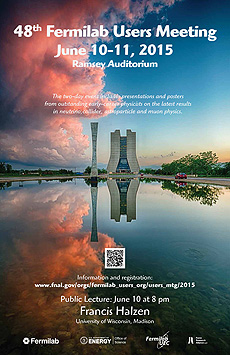Fermilab Users Meeting to celebrate past and future discoveries - June 10-11
 |
The 2015 Fermilab Users Meeting takes place from June 10-11. The popular Festa Italiana will take place on Tuesday evening, June 9. Registration is now open. |
Fermilab researchers will have plenty to celebrate at this year's Users Meeting, which takes place at the laboratory from June 10-11. This year researchers formed the Deep Underground Neutrino Experiment collaboration, strengthening Fermilab's position at the forefront of neutrino research. Along with Argonne National Laboratory, Fermilab recently hosted an accelerator stewardship pilot program to reach potential partners in industry. And just last month, scientists celebrated the 20th anniversary of the top quark discovery at Fermilab.
The 48th annual Users Meeting will address all of these topics, in addition to other news in astroparticle, accelerator, collider, muon and neutrino physics.
"This is a pivotal year. With the release of the P5 recommendations, DOE and Fermilab are both firmly behind building a strong neutrino program," said Users Executive Committee co-chair Bill Louis of Los Alamos National Laboratory. "This is really terrific. It puts Fermilab at the center of neutrino research in the world."
The popular Festa Italiana will take place on June 9, the evening before the Users Meeting officially kicks off. Registered attendees are invited to come socialize with other Fermilab users over food and beverage.
In a special event on June 10, the American Physical Society will recognize Fermilab's pivotal contributions to high-energy physics, naming Fermilab a historic site.
On June 10 at 8 p.m. in Ramsey Auditorium, Francis Halzen of the University of Wisconsin–Madison will give a public talk titled "Ice Fishing for Neutrinos." He will discuss the IceCube experiment, where researchers are looking for astronomical messengers — neutrinos — from giant black holes gobbling up stars and from gamma ray bursts. Tickets can be purchased through the Fermilab Lecture Series box office.
"His talk will be an exciting one," said Users Meeting Deputy Chair Thomas Strauss of the University of Bern. "He'll give a great view of an important neutrino experiment happening outside Fermilab."
Two days before the Users Meeting, on June 8-9, the Fermilab Student and Postdoc Association will hold its annual New Perspectives Conference, a day and a half of talks given by undergraduate, graduate and postdoctoral researchers. The group will also host a poster session during the banquet on the first day of the Users Meeting.
"We are very excited that this year's meeting will showcase all of the great things that have been happening at Fermilab as well as all of the wonderful projects that are about to start," said Users Meeting Chair Bill Lee of Fermilab.
Please register for the Users Meeting by June 1. Learn more by viewing the agenda or visiting the event website.
"The Fermilab present and future programs are very exciting, and I would not be surprised at all if one or more major discoveries are made in the next five or 10 years," Louis said. "There are many experiments running and more being built and planned. So it will be an especially interesting meeting."
—Leah Hesla
|